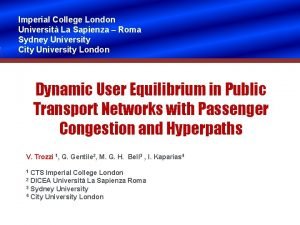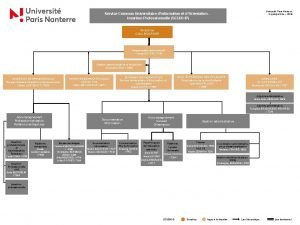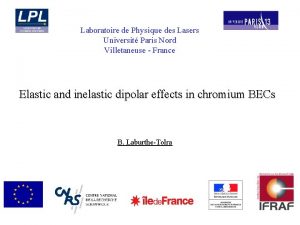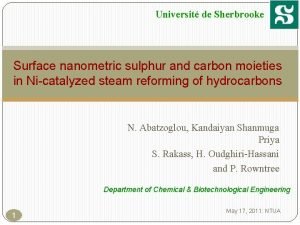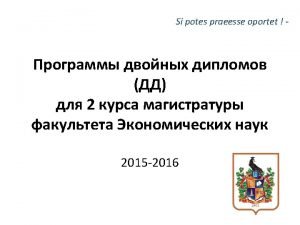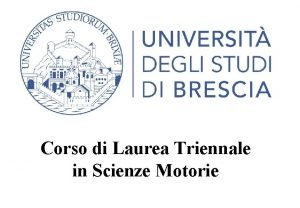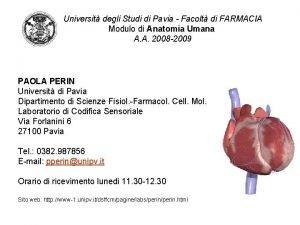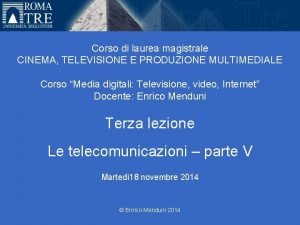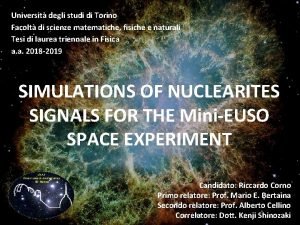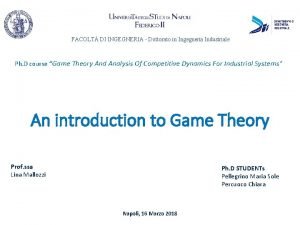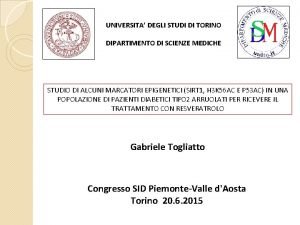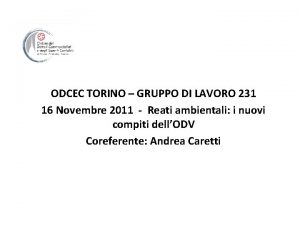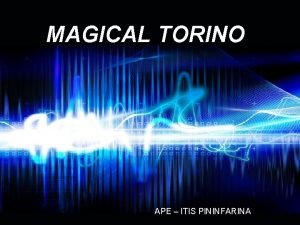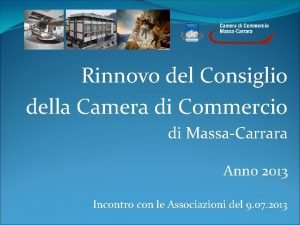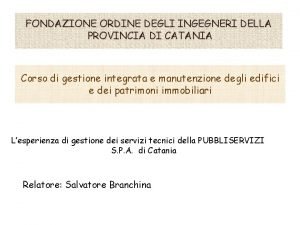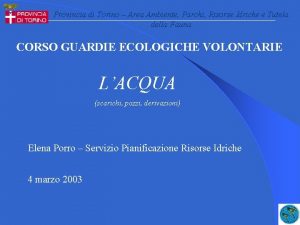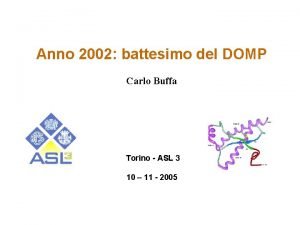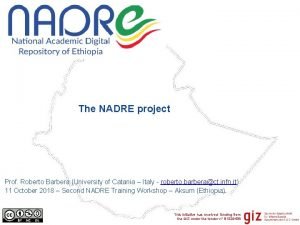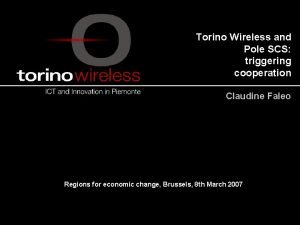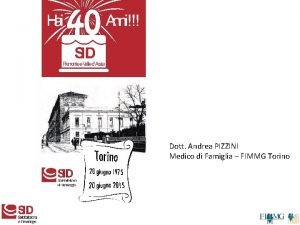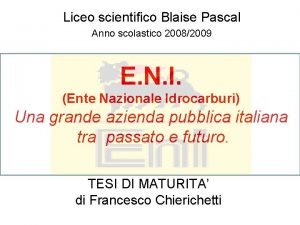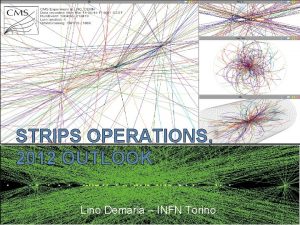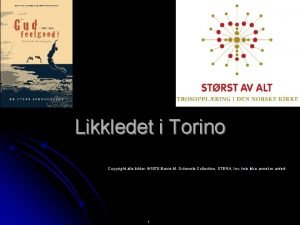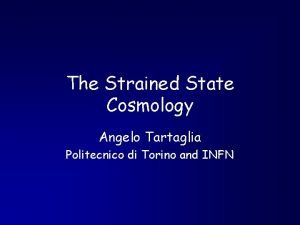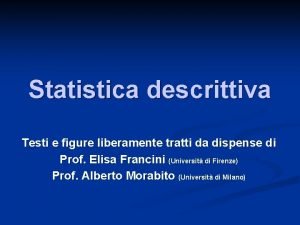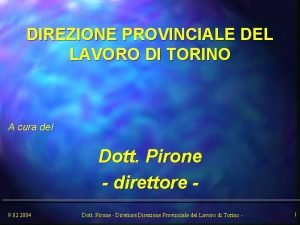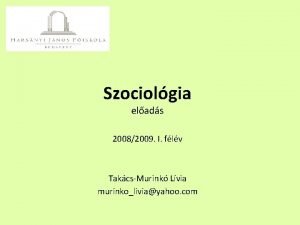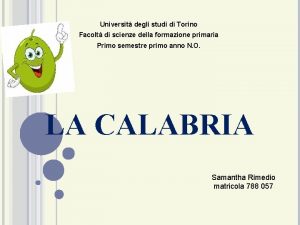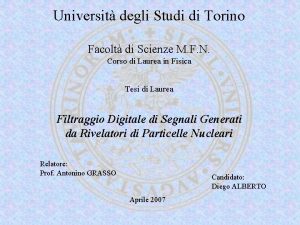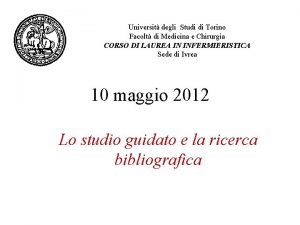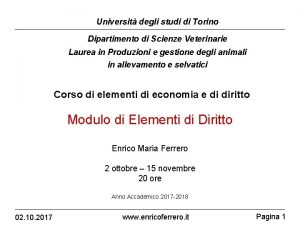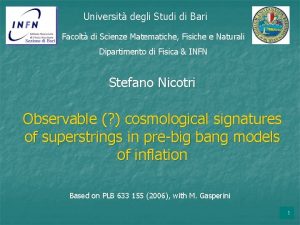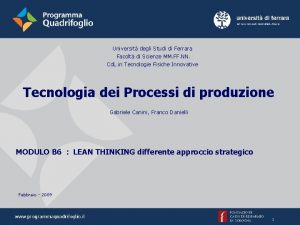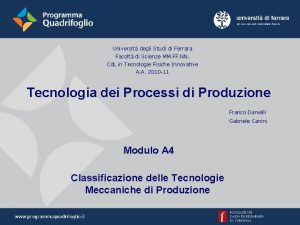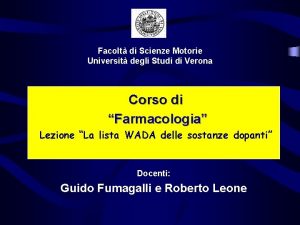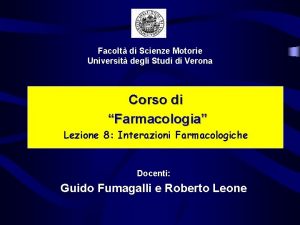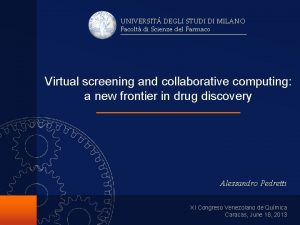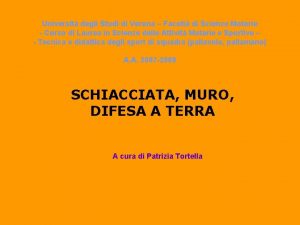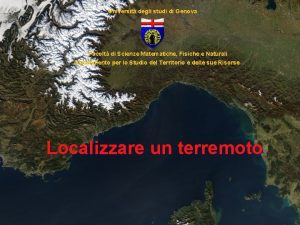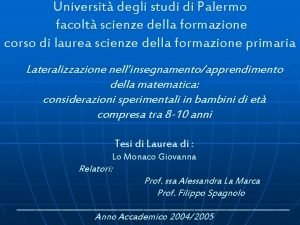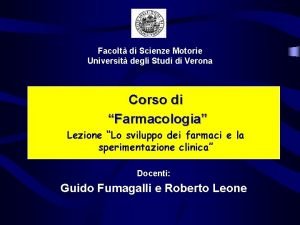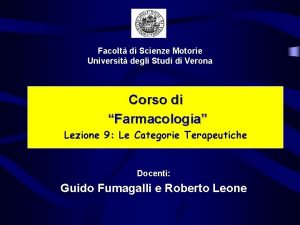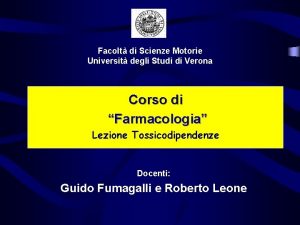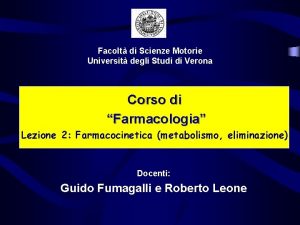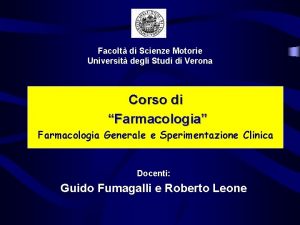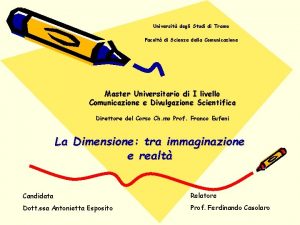Universit degli studi di Torino Facolt di scienze



















































- Slides: 51

Università degli studi di Torino Facoltà di scienze matematiche, fisiche e naturali Tesi di laurea triennale in Fisica a. a. 2018 -2019 SIMULATIONS OF NUCLEARITES SIGNALS FOR THE Mini-EUSO SPACE EXPERIMENT Candidato: Riccardo Corno Primo relatore: Prof. Mario E. Bertaina Secondo relatore: Prof. Alberto Cellino Correlatore: Dott. Kenji Shinozaki

AIM OF THE STUDY 1. Simulation of nuclearites in the Field of View (FOV) of the Mini-EUSO 2. Verification of such a simulation by modelled events 3. Determination of the Mini-EUSO’s nuclearites’ upper limit flux for null detection 2

INTRODUCTION 3

Mini-EUSO is an UV telescope installed in the Russian Zvezda Module of the ISS. It’s part of the mission Beyond begun on the 20 th of July 2019. Mini-EUSO has been installed on the ISS since the 27 th of August 2019. Its main goal is the measurement of the UV emissions of interacting particles in Earth atmosphere. Interaction emissions differ in light profile, depending upon the particle causing them, its velocity and mass. Particles can be meteors, space debris or Strange Quark Matter (SQM, Nuclearites). All measurement will be made by night. 4

INSTRUMENT: OVERVIEW Mini-EUSO is situated inside the ISS behind an UV-transparent window from which it observe the Earth in a fixed position facing the nadir direction. The full Mini-EUSO telescope is made up of 3 main systems, the Optical System, the Focal Plane (PDM) and the Data Acquisition System. Instrument dimensions: 37 x 62 cm 3 5

NUCLEARITES: STRUCTURE • Nuggets of Strange Quark Matter (SQM): clumps of Stranglets, made of about same number of up, down and strange quarks, captured electrons to reach neutrality. • Baryonic Number greater than 106. Stable for any value: Nuclearites: A > 106, core + electrons, neutral. Stranglets: A < 106, positive charged. • Size from 10 -8 cm through any value for example dimensions of neutron stars. 6

NUCLEARITES: ORIGIN Possible origin: • Primordial nuclearites: Residuals from the transition period from the quasi-free quark plasma to the cooler state where quarks are confined. According to theory of Quantum Chromodynamics (QDC) they are vestiges of the Big Bang. • Recent nuclearites: products of the collision of neutron stars or supernovae bursts. Strange Quark Matter is non-luminous and it may constitute the dark matter. De Rujula & Glashow, Nature 312 (1984) 734 7

NUCLEARITES: SPEED and MASS • Speed ranges from about 250 to 500 km/s. They are not subject to ablation phenomena. • Mass determines Magnitude and Maximum Altitude: Magnitude If Absolute Magnitude (calculated at standard height h = 100 km): Maximum Altitude: Nuclearites are expected to be a low atmosphere phenomenon: • 10 -4 g nuclearite hmax ~ 6 km • 104 g nuclearite hmax ~ 60 km 8

NUCLEARITES vs METEORS Nuclearites are faster than Meteors: The light emitted by nuclearite is constant at h hmax. Meteors move only downwards while Nuclearite can move also upward (mass greater than 0. 1 g). 9

NUCLEARITES vs METEORS Light curve of: Nuclearites Meteor • two nuclearites, one up- and one downwards moving • a meteor Model parameters Nuclearites: • mass: m = 20 g • velocity: 250 km/s • θ = 45° inclination from the vertical. Meteor: • magnitude: M = − 1 • velocity: 70 km/s • θ = 45° 10

FIELD OF VIEW (FOV) 11

FOV: PROPERTIES Pyramidal shape. Vertices: ISS, 400 km from Earth’s ground. Angle at vertices: 50°. Mini-EUSO FOV is 44° wide: 50° prevents data loss. Space isotropy and constant flux of particles. Nuclearites have a constant light emission and a constant mass. 12

FOV: DISTRIBUTION ON EACH FACE AND ON BASE Total number of events on the faces (NFaces ): 100 000 Total number of events on the base (NBase ): 42 261 (proportional to base to faces area 13 ratio)

FOV SPACE ISOTROPY: Face, Face : azimuth angle : zenithal angle For a given event, both Face and Face are randomly generated. [rad] varies from 0 to 2. The distribution of events vs is constant. varies form 0 to /2. The distribution of events vs is proportional to sen cos [rad] 14

FOV SPACE ISOTROPY: Base, Base : azimuth angle : zenithal angle For a given event, both Base and Base are randomly generated. [rad] varies from 0 to 2. The distribution of events vs is constant. varies form 0 to /2. The distribution of events vs is proportional to sen cos [rad] 15

FOV: ASSUMPTIONS Each event in the FOV receives a random mass and velocity, hence a maximum altitude: Speed range: 250 -500 km/s Mass range: 5 -100 g Maximum altitude as expected from the assigned mass Analyzing for each event the coordinates (x, y, z ) at any time, the SW checks following the nuclearite as it reaches the hmax or it leaves the FOV. 16

SIMULATIONS 17

NUCLEARITE SIMULATIONS The simulator can operate in two RS one ground based and the other ISS based, the latter only was considered. It simulates the path of the nuclearite and associated light curve with a time tick of 1 ms, accounting also for the boundary conditions of: z • FOV • hmax Mini-EUSO z y x FOV y 7. 8 km/s 400 km Ground Simulator x EARTH 18

SIMULATION I/O INPUT Mass (Range: 5 - 100 g) Horizontal speed of Mini-EUSO Initial coordinates of Mini-EUSO Duration of the event Velocity of nuclearite Maximum height of nuclearite light emission that can be registered by Mini-EUSO OUTPUT Event duration Path on the focal plane Number of photons registered vs time (light curve) and angles Position (x, y, z) in respect to Mini-EUSO Simulation run on 10 000 nuclearites 19

# photonenlectrons / 1 ms FROM FACES Nuclearite 1: Light curve, Nuclearite 1 mass = 65. 30 g hmax = 41. 9 km vminieuso = v. ISS = 7. 8 km/s , along x Duration of the event: 0. 839 s Mini-EUSO Nuclearite motion: upward Earth 20

READING THE LIGHT CURVE # photonenlectrons / 1 ms The maximum of the Light Curve represent the nearest point of the nuclearite’s trajectory to the ISS. We observe this kind of bell shape because after the maximum the ISS moves in the opposite direction of the nuclearite and by consequence Mini-EUSO can detect less photons. Light curve Nuclearite 1, Zoom Approaching the ISS Note: This interpretation is similar for all the examples of nuclearites reported in this presentation. Moving away from the ISS 21

# photonenlectrons / 1 ms Light curve, Nuclearite 2 FROM FACES Nuclearite 2: mass = 95. 88 g hmax = 42. 9 km vminieuso = v. ISS = 7. 8 km/s , along x Duration of the event: 0. 170 s Mini-EUSO Nuclearite motion: downward Earth 22

# photonenlectrons / 1 ms FROM BASE Light curve, Nuclearite 3: mass = 37. 89 g hmax = 40. 4 km vminieuso = v. ISS = 7. 8 km/s, along x Duration of the event: 0. 709 s Mini-EUSO Nuclearite motion: upward Earth 23

VELOCITY VECTORIAL COMPONENTS VX Origin of the coordinate system is in Mini. EUSO: • Velocity components along x or y can be both positive and negative • Velocity component along z can be both positive or negative because nuclearties can pass through the Earth VY VZ Downward motion Upward motion 24

DISTRIBUTIONS: t, m, hmax, TRACK WIDTH More fast events than slow. 25

This graph shows that the distribution of hmax and mass is correlated by an exponential. This is the result of the relation between the two. Correlation between track width and time. Events with durations shorter than 0. 1 s are not considered as too fast for a significant analysis. This will be verified adding data from a meteors simulation. 26

HORIZONTAL SPEED FOR NUCLEARTES AND METEORS Nuclearites Distribution, for nuclearites and meteors, of the ratio of track width and the duration of the single event. The meteor distribution of track width and time ratio helps to understand where the cut is to be made. Meteors The cut conditions will be imposed considering limitations on the duration of the events, the (track width/time) value and the maximum emissions of photons. Photons / GTU 27

UPPER LIMIT OF NUCLEARITES’ FLUX, THEORY The following relations report the value of the constant K and the upper limit of nuclearites’ flux for a null detection that can be observed with Mini-EUSO ( Ph, 0). Ph, 0 expression derives from the result of the integral that give the probability to obtain Ph, 0 with a Confidence Level (CL) of 90%. Hypothesis: • T = 30 days = 2 592 000 s • AFOV = 4. 68 * 1015 cm 2 • ε = N / 1 000 • CL = 90 % 28

CUT CONDITIONS Distribution of (track width/time) after the cut Data acquisition > 0. 1 s (track width / time) > 20 pixels/s Max emission > 40 photons / GTU N = 110 events Ph, 0 = 5. 5 * 10 -22 cm-2 sr-1 s-1 8 ph / GTU Distribution of (track width/time) after the cut 40 ph / GTU 29

Photonselectrons/ GTU INTERVAL OF MASS CUT 3 CUT 2 CUT 1 30

ESTIMATED UPPER LIMIT OF NUCLEARITES’ FLUX Preliminary With the most conservative cut condition we obtain that the sensitivity of Mini-EUSO at 90% of CL is: Ph, 0 = 5. 5 * 10 -22 cm-2 sr-1 s-1 The 30 days indicated as acquisition time are to be understood as effective acquisition time: the total acquisition time in which observations were made in the best conditions, for example above the Oceans and clear sky. Ph, 0 Mini-EUSO (30 days) 31

SUMMARY Generation of the FOV of Mini-EUSO Simulated analyzed nuclearites’ signals Estimated the nuclearites’ flux upper limit for a null detection for 30 days of Mini-EUSO work 32

FIRST SET OF DATA FROM Mini-EUSO Between the night of 7 th and 8 th of October there was the first observation of Mini-EUSO lasted about 40 s. At that moment the ISS was flying between Ethiopia and Sudan. Probably the photons registered came from Thunderstorm or Lightnings. 33

34

MORE DETAILS… THANK YOU! 35

A DEEPER VIEW 36

INSTRUMENT 37

INSTRUMENT: OPTICAL SYSTEM Operation of the two Fresnel lenses Two double sided Fresnel lenses. Diameter: 25 cm Thickness: 11 mm Weight: 0. 8 kg Wavelength accepted: 300 -400 nm, UV band Each lens is made of PMMA. The effective focal lens is 300 mm and the FOV is 44°. 38

INSTRUMENT: PDM The two lenses focuses the light on to a focal surface consisting of a single PDM, made up of 36 MAPMTs and 2304 pixels. The two acronyms stands for: • PDM: Photo Detector Module • MAPMT: Multi-Anode Photomultiplier Tubes 39

INSTRUMENT: VISIBLE and IR CAMERAS There also two IR cameras for complementary measurement in the NIR (Near IR , range from 1500 to 1600 nm) and in the visible (VIS from 400 to 780 nm). The main task of the cameras is to provide an atmospheric monitoring in order to better understand the UV luminosity measurement. The NIR and VIS cameras will operate with a trigger passed from the Mini. EUSO PDM in order to provide multiwavelength measurements of slower atmospheric events, such as meteors and nuclearites. When not triggered, the cameras will operate continuously to provide complementary measurements on the atmospheric status at the time of measurement, matching the third level of data from 40 the Mini-EUSO trigger.

INSTRUMENT: DATA ACQUISITION SYSTEM Consists of the front-end electronics, the PDM -DP (PDM data processing) subsystem based on a Xilinx Zynq XC 7 Z 030 system on chip and a PCIe/104 form factor CPU. Incoming photon pulses are preamplified and digitized at intervals of 2. 5 μs, referred to as the Gate Timing Unit or GTU. The signal is then triggered and time-stamped in the Zynq FPGA, before being passed to the CPU for data management and storage. The Zynq chip is responsible for of the majority of the data handling including data buffering, triggering, synchronization and interfacing with the separate CPU system. The CPU performs the control of the instrument sub-systems as well as the data management and storage, housekeeping, switching between operational modes and collecting data from the NIR and VIS cameras. Data is stored on board in SSDs which are periodically returned to Earth from the ISS. 41

NUCLEARITE PROPERTIES 42

ADDITIONAL NUCLEARITES PROPERTIES Ground state of nuclear matter (E/A < 930 Me. V). Density is 3. 6 x 1014 g cm-3. The principle energy-loss mechanism for a nuclearite passing through matter is by atomic collision and is expressed in this relation: A = Effective Cross-sectional area, = Density of the medium, v = Speed. Cross-Section area A Emitted energy follows a blackbody relation, ensuring fluxes in the interval of wavelength covered by Mini-EUSO. 43

DARK MATTER 44

DARK MATTER (1) Dark matter is a form of matter thought to account for approximately 85% of the matter in the universe and about a quarter of its total energy density. Its presence is implied in a variety of astrophysical observations, including gravitational effects which cannot be explained by accepted theories of gravity unless more matter is present than can be seen. Dark matter is abundant in the universe and have had a strong influence on its structure and evolution. Dark matter is called dark because it does not appear to interact with observable electromagnetic radiation, such as light, and is thus invisible to the entire electromagnetic spectrum, making it undetectable using existing astronomical instruments. 3 D map of the large-scale distribution of dark matter, reconstructed from measurements of weak gravitational lensing with the Hubble Space Telescope. 45

DARK MATTER (2) Primary evidence for dark matter comes from calculations showing many galaxies would fly apart instead of rotating, or would not have formed or move as they do, if they did not contain a large amount of unseen matter. Other lines of evidence include observations in gravitational lensing, from the cosmic microwave background, also astronomical observations of the observable universe's current structure, the formation and evolution of galaxies, mass location during galactic collisions, and the motion of galaxies within galaxy clusters. In the standard Lambda. CDM model of cosmology, the total mass-energy of the universe contains 5% ordinary matter and energy, 27% dark matter and 68% of an unknown form of energy known as dark energy. Thus, dark matter constitutes 85% of total mass, while dark energy plus dark matter constitute 95% of total mass–energy content. Because dark matter has not yet been observed directly, if it exists, it must barely interact with ordinary baryonic matter and radiation, except through gravity. The primary candidate of constituent for dark matter is the nuclearites. Dark matter is classified as "cold", "warm", or "hot" according to its velocity (more precisely, its free streaming length). Current models favor a cold dark matter scenario, in which structures emerge by gradual accumulation of particles. 46

CUT CONDITIONS 47

CUT CONDITIONS 1 Duration of the data acquisition > 0. 1 s (track width / time) > 20 pixels/s Max emission of photons > 8 photons / GTU N = 467 events Ph, 0 = 1. 3 * 10 -22 cm-2 sr-1 s-1 Note: 1 GTU = 2. 5 μs 48

CUT CONDITIONS 2 Duration of the data acquisition > 0. 1 s (track width / time) > 20 pixels/s Max emission of photons > 20 photons / GTU N = 372 events Ph, 0 = 1. 6 * 10 -22 cm-2 sr-1 s-1 49

CUT CONDITIONS 3 Duration of the data acquisition > 0. 1 s (track width / time) > 20 pixels/s Max emission of photons > 40 photons / GTU N = 110 events Ph, 0 = 5. 5 * 10 -22 cm-2 sr-1 s-1 50

REFERENCES • Francesca Capel, Alexander Belov , Marco Casolino, Pavel Klimov, for the JEM-EUSO Collaboration Science. Direct Advances in Space Research 62 (2018) 2954– 2965 • JEM-EUSO: Meteor and nuclearite observations M. Bertaina · A. Cellino · F. Ronga · The JEM-EUSO Collaboration, Exp Astron DOI 10. 1007/s 10686 -014 -9375 -4 • E. Witten Phys Rev D 30(1984) 272 A • De Rujula & Glashow, Nature 312 (1984) 734 • Thesis of Giulia Bruno and Antonio Montanaro • Francesca Bisconti, Presentazione notte dei ricercatori Mini-EUSO, 27/09/2019 • https: //ned. ipac. caltech. edu/level 5/Leo/Stats 5_4. html 51
 Universit of london
Universit of london Organigramme nanterre
Organigramme nanterre Universit
Universit Universit sherbrooke
Universit sherbrooke Rotterdam school of economics
Rotterdam school of economics Unibs scienze motorie piano di studi
Unibs scienze motorie piano di studi Università degli studi di genova erasmus
Università degli studi di genova erasmus Ingegneria gestionale parthenope
Ingegneria gestionale parthenope Facoltà di farmacia pavia
Facoltà di farmacia pavia Università degli studi di firenze psicologia
Università degli studi di firenze psicologia Università degli studi roma tre mascotte
Università degli studi roma tre mascotte Facolt
Facolt Facolt
Facolt Facolt
Facolt Facolt
Facolt Idoneit
Idoneit Facolt
Facolt Match the verbs 1-6 with the nouns a-f
Match the verbs 1-6 with the nouns a-f Facolt
Facolt Facolt
Facolt Sirte torino
Sirte torino Odcec torino
Odcec torino Itis pininfarina torino
Itis pininfarina torino Torino
Torino Giulia beccaria torino
Giulia beccaria torino Haggen dazz
Haggen dazz Rinnovo smart card camera di commercio
Rinnovo smart card camera di commercio Residenza borsellino torino
Residenza borsellino torino Fondazione ordine ingegneri catania
Fondazione ordine ingegneri catania Tribunale bruno caccia torino
Tribunale bruno caccia torino Risorse idriche torino
Risorse idriche torino San donato calcio torino
San donato calcio torino Carlo buffa neurologo torino
Carlo buffa neurologo torino Prof barbera
Prof barbera Timbrella
Timbrella Via castelgomberto 73
Via castelgomberto 73 Torino wireless
Torino wireless Fimmg torino
Fimmg torino Liceo scientifico blaise pascal torino
Liceo scientifico blaise pascal torino Infn torino webmail
Infn torino webmail Where is the international training centre
Where is the international training centre Modulo censimento atc torino
Modulo censimento atc torino Boella torino
Boella torino Kledet
Kledet Cassa dottori commercialisti torino
Cassa dottori commercialisti torino San camillo torino riabilitazione
San camillo torino riabilitazione Tartaglia triangolo
Tartaglia triangolo Ilotte vincenzo
Ilotte vincenzo Coppia torino
Coppia torino Direzione provinciale del lavoro torino
Direzione provinciale del lavoro torino Torino smart city
Torino smart city Lvia torino
Lvia torino
